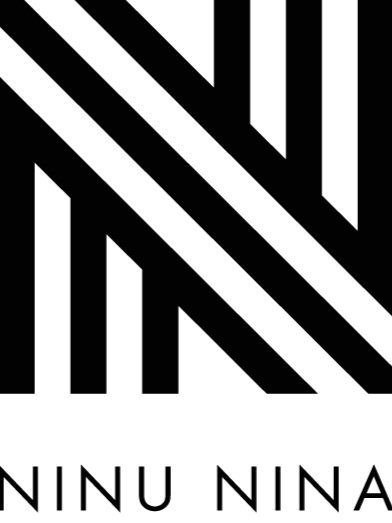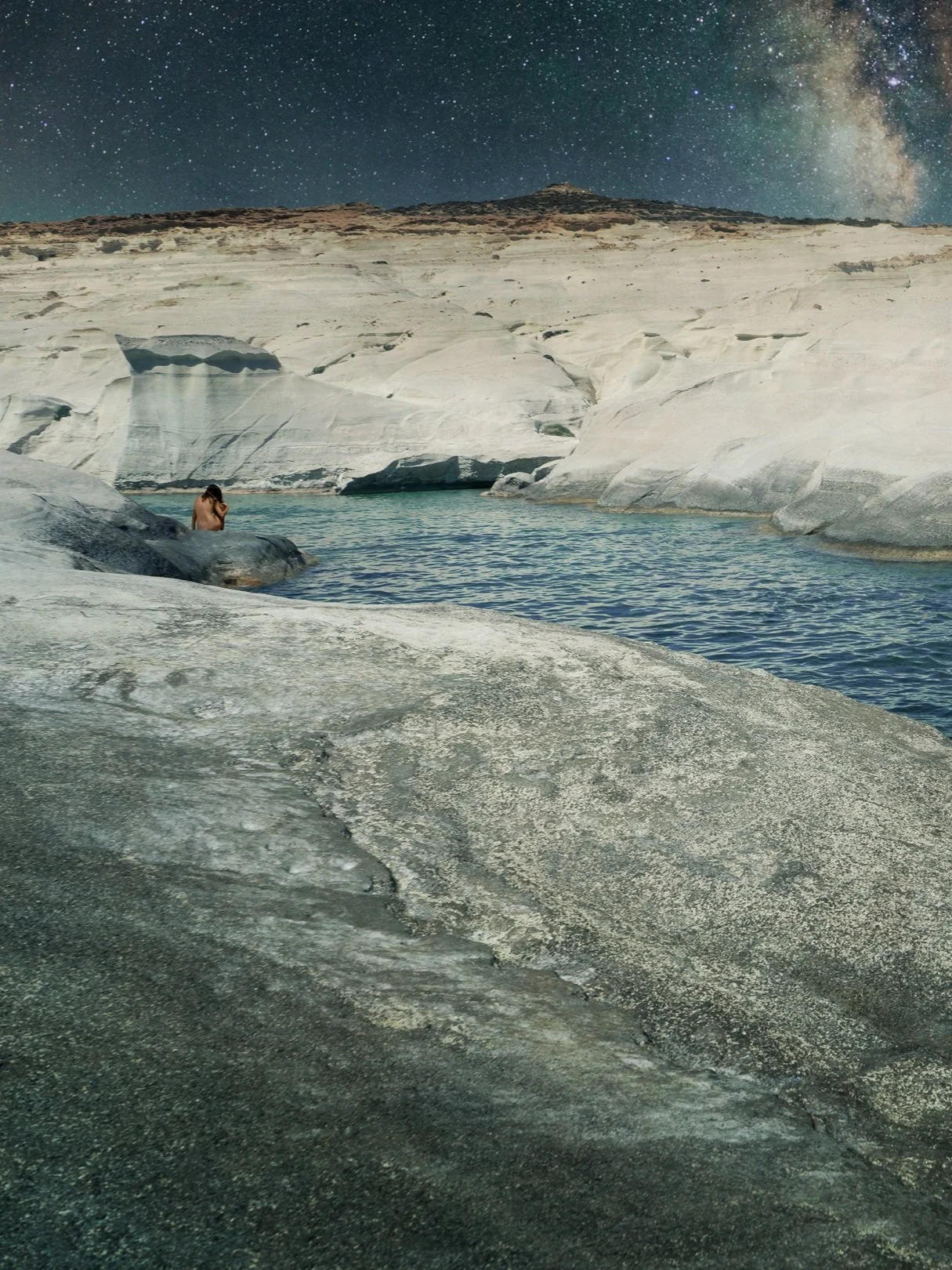LAUREL JOHANNESSON INTERVIEW
Her work often takes place in or around water in site-specific locations and depicts uncanny juxtapositions between body and nature, realism and dream. She works across various mediums, including photography, digital collage and painting, as well as moving images and interactivity to create imagery that addresses our understanding of time and space. She is particularly interested in the beach as a liminal or temporal space and the intersection of art and technology. Her current series, Situations, explores beautiful yet uncanny landscapes that are combinations of celestial bodies with her own body on shorelines in Greece.
Your greatest inspirations or influences?
I'm primarily inspired by cinema. Whether I'm working on a still or moving image, I'm thinking about the narrative. What has just happened? What will happen next? In many ways, my creative process feels more like plotting a course through a sea of stories than creating a single artwork. I tend to think of the figures in my work as a recurring cast. They are essentially meant to represent the same individual, but they are playing different parts. Each with their particular pose has a different attitude and mood. When I insert them in the landscape, I consider whether that specific figure belongs in that specific scene. What is their posture saying? What part are they playing?
I'm sure beach scenes in films like Fellini's Juliet of the Spirits or La Dolce Vita, or the final end of the world scene in Lars von Trier's Melancholia, have influenced me in some way. When Fellini's characters find themselves at the beach they appear to attain a form of self-realization that is instinctive and corporeal as the connection between the characters and the sea appears to act as a catalyst. The beach is neither land nor sea. It is constant and yet constantly changing. It is often a place of naked truth, of judgement, a site of initiation into consciousness. In von Trier's Melancholia, the three characters are all waiting for the end of the world. Sitting in their make-shift stick tent, they appear small and somehow insignificant in the middle of a vast and idyllic landscape. They are protected and at the same time exposed. One is crying, one is perhaps in shock or accepting, another almost seems indifferent. I love that kind of tension. It's something I strive for in my work.
I'm also heavily influenced by philosophies of temporality and the contemporary interpretations of those philosophies. I'm inspired by the invisible world and inner landscapes… spaces where time is stretched to infinity, where delicate shifts of light can create an eternity, and where sound goes beyond hearing.
You’ve written previously about the “day for night” cinematic technique as being an inspiration in your current work. What draws you to that uncanny quality?
Filmmaking is all about creating the illusion of reality, not necessarily recreating reality, but rather a poetic impression of reality. The "day for night" technique has been used for decades to give the illusion of a night scene while being shot in the daytime under sunlight. Of course, some of the effects of the sunlight remain even after underexposing the image, using a neutral density filter, adding a blue cast, etc. For example, the shadows may look unnaturally sharp, and the sky may be illuminated in a way that no camera could capture the night sky. These unnatural and somewhat uncanny aspects of the "day for night" technique employed in filmmaking are attractive to me. Although I am not utilizing the exact "day for night" technique used in filmmaking, I am trying to replicate some aspects of it through the extreme shadows and brightly lit night sky. I strive to create an image that has some subtly uncomfortable or awkward elements that are not immediately obvious to the viewer. The image is neither day nor night. It could be viewed as some sort of purgatory, or perhaps it's paradise.
Can you tell us a bit about your creative process?
I have created an enormous archive of what I call "base images". I’ve collected these while spending extended periods of time in Greece and Italy, where I photograph the locations and figures in response to the place, and then I work out the narrative over time later in the studio. Once I'm back in the studio, I look through my photographic archive, sometimes searching for a specific location. Then I'm taken back to the place where I photographed the original images—images that I will ultimately deconstruct and reconstruct into real and imagined scenarios. It's like a strange form of time travel, and suddenly I think that I can almost feel the negative ions from the sea, and then the process starts to flow, and the real work begins. I digitally collage bits and pieces together, and the final images end up directly printed on metal, sometimes on paper, and as bespoke lightboxes. Lately, I've been animating some of the images with particular aspects of the image remaining static and frozen in time while other parts move subtly in the wind or are rained down upon in a torrential downpour. I'm also working on an interactive moving image that will respond to the viewer's presence... but that's a long story.
Art and technology are important to your practice. What do you hope art can learn from technology, or vice versa?
In 2008, I began creating interactive and generative works. These interactive generative works provided me with an opportunity to become familiar with working with code and to put into practice some forms of viewer interaction. However, I was frustrated by what I felt was a limitation of generative art and interactive installation. While the primitive forms of self-generative systems (a wind chime is one example) easily maintain their lyrical quality, I felt that as soon as I attempted to bring in any interactive aspect to the work, it often became mechanical in appearance thus destroying any subtleties, or elements of aesthetic emotion. While the simple path might have been to focus more on the technical details—and I did that as well!—I felt that an investigation into aspects of time would inform the work more thoroughly and help sort out my misgivings. After a great deal of research into both the technological aspects of generative and interactive work and the philosophical aspects of temporality, I am now trying to create a more subtly ubiquitous experience for the viewer. I do not want the human to be immediately aware that the machine is responsive to them. But rather the more time they spend with the image (actually a machine disguised as an illuminated photograph), the clearer it becomes that their presence has been noticed and is being responded to. To quote Elise Co, "much of what is so enticing about natural phenomena – the mystery, the unpredictability – is contrary to what we want from machines. However, I think we should start to think of machines less as boxes of practicality and more as generic control mechanisms for mediating all kinds of interactions and stimuli." Now with digital technologies, the artwork can become a simulation of reality and contain the mystery and unpredictability of a natural phenomenon — a synthetic space that the visitor enters and becomes a traveller in a temporal environment of sensual information.
*In Maeda, John. Creative Code: Aesthetics + Computation. Thames & Hudson, 2004. p. 172.
How has the pandemic changed your creativity or how you see the world changing moving forward?
Initially, the pandemic and not being able to travel affected my work. Unable to add to my archive of base images, I became more reliant on my existing archive. I had to mine that archive, and what at first seemed a hindrance actually turned out to be a positive development. I was forced to be more creative and resourceful, hunting through images and challenging my memory to find an elusive element that I knew was there somewhere.
In addition, I believe that the pandemic and our increasing comfort with life online or in the metaverse accelerated NFTism. Given my fascination with art and technology, it's been of great interest to me. I'll be releasing some of my moving images as NFTs sometime soon, and I'm looking forward to exploring this new platform for creativity and dissemination.
What drove your decision to move from taking photographs under the water to the shoreline, which features prominently in your current work?
I started photographing the beach after many years of underwater photography. For a long time, I was totally focused on the water and the perception of suspended time when you are underwater. However, over the years, I began to notice people at the seaside and how they stare at the water, seemingly mesmerized. Often, something in their posture and expression conveys longing—or what I interpret as longing—for something unreachable or unknowable. Similar to what I observed on film in those Fellini beach scenes, the instinctual and physical connection between the body and the sea appears to act as a catalyst for some kind of self-knowledge. The underwater work responded to a singular and sensual connection with the element of water, where the work at the shoreline is more of a psychological exploration that is allowing me more space and options for a narrative perception of temporality that can still veer to the sensual but can also observe the arcane.
In a recent interview, you called the visual language of your series, Situations, “apocalyptic.” What do you mean by that?
To me, the images live in a limbo space. Sitting somewhere between night and day, or perhaps a combination of night and day, is a better description. They are in a liminal space in a temporal sense. The figures often appear slightly uncomfortable and are alone, even when more than one is depicted. They are small and insignificant in the vast and harsh environment. The night sky, both beautiful and imposing, looms over their sunny landscape. They are vulnerable and exposed... waiting for the end of the world.
Instagram: @laurel_johannesson




